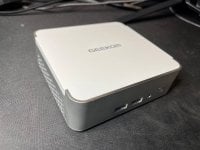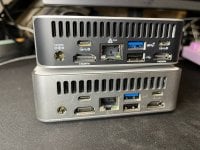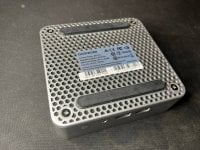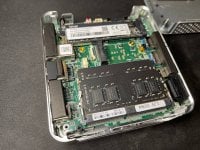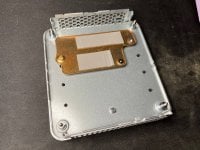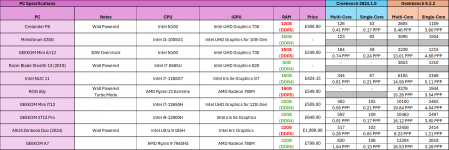General Information
A New Intel-Flavoured Machine
In terms of branding the XT12 Pro finds itself in an awkward position. On paper we have as 12th Generation i9 housed in a new and relatively aesthetically-pleasing shell from Geekom. On top of the silver metal exterior (which is itself full of holes for ventilation) we see a matte white plastic top. It looks great and feels like a nice middle-ground between the mini Mac Mini aesthetic of the A7 and the more boxy NUC design we've seen in the IT series. It's all nice and new, but given this is a 12th Generation Intel chip on show, I am curious why this isn't just being released as an extension of the IT12 line, especially when the IT13 has an i9 model itself. It's possible they wanted to use a different name to avoid a new product feeling old, but it does somewhat muddy what I would consider a previously simple to follow naming scheme.
Looking to the IO options it's just as plentiful as you might expect if you've seen a Mini PC review before. On the front we see two SuperSpeed USB A ports next to a 3.5mm headphone jack and the power button. To the left we see the return of the Kensington lock, and on the back we get two Thunderbolt 4s, two HDMIs, two USB As, with one again being SuperSpeed, and a 2.5G Ethernet port. For those really paying attention, you'll know that is almost one for one the same IO as the A7 before it, with the only notable changes being an upgrade to one of the back USB C ports and the lack of an SD card reader on the right side of the unit. It is a shame to see the SD port dropped here, so I'm hoping it's not a change that sticks in future designs.
It's What's on the Inside That Counts
Under the hood we find the previously mentioned i9 12900H CPU accompanied by 32GB of DDR4 RAM and a 1TB SSD, with both the RAM and SSD being easy to access by removing four screws on the bottom and prying the case apart. You do also get an additional slot for a smaller 2242 SATA SSD if you want to make the most of the system, with thermal pads already applied over both SSD slots to keep them cool. I'm a little sad to see the smaller form factor of the case again remove the possibility of adding in a 2.5 inch drive, but I do feel this is becoming less of a big deal as the price of M.2 SSDs continues to fall. If that is something that does matter to you, both the IT12 and IT13 lines do at least support these.
With there only being one configuration on offer this time, I do think the system is specced reasonably well. Between the 1TB of storage and 32GB of RAM, most people buying the system will be covered for a good while. If they do choose to upgrade though, it's great to see Geekom return to non-destructive means of entry. Removing rubber feet isn't much effort for systems like the A7, but I can never seem to do it without some kind of damage.
As always you can find the full spec sheet below if you want to peruse it:
Size: 117 x 111 x 38.5mm
CPU:
- 12th Gen Intel Core I9-12900H
- ADL-H (Enthusiast) TDP 35W
Memory: Dual channel DDR4 260PIN 3200MHz SODIMM, up to 64GB
Storage: 1 x SSD (NVMe Gen 4 x 4)
I/O Ports:
- 1 x Rear USB 3.2 Gen 2 Type-A, 1 x rear USB 2.0 Type-A
- 1 x Front USB 3.2 Gen 2 Type-A support Power delivery & 1 x front USB 3.2 Gen 2 Type-A
- 2 x USB 4 Gen3 Type-C support Power Delivery (back panel)
- 1 x 3.5mm front stereo headset jack
- 1 x RJ45 (back panel)
- 2 x HDMI 2.0 (back panel)
- 1 x DC in (back panel)
- 1 x Power Button
- 1 x Kensington Lock
- 1 x M.2 key-M slot for PCIe Gen 4 x4 NVMe SSD
- 1 x M.2 key-B slot (SATA)
- 1 x M.2 2230 for WIFI
- 1 x FAN
Ethernet: Intel 10/100/1000/2500 Mbps RJ45
Wireless LAN:
- M.2 Wi-Fi 6E Bluetooth 5.2, 22mm*30mm*2.4mm
- XB591
DTPM2.0: N0
Battery: RTC coin battery
Adapter: 19V 6.32A
PCBA Dimension: 105.75*102.9*1.6mm
Certification: CE, FCC, CB, RoHS
Operating System: Microsoft Windows 11 (64-bit)
Accessories: VESA Mount (option)
Not Quite the King
Onto the performance, the XT12 Pro finds itself sat distinctly between the IT12 and A7 I've reviewed previously, and at its £649 price point that's exactly what I'd expect. What I didn't expect however is just how little the improvement actually is over the i7 IT12 I have on hand. Going through the synthetic benchmarks we see scores of 10463 and 2497 for Geekbench 6.2.2's multi-core and single-core results respectively. The IT12 for comparison fell just slightly behind with 10100 and 2463. Cinebench 2024.1.0 did show a bit more of a gap, with the XT12 Pro scoring 592 on the multi-core test and 109 on the single-core. You can see how it stacks up against other systems I own below:
When it comes to gaming the XT12 Pro maintains a steady lead in performance over the IT12, but much like the synthetic scores there isn't all that much in it. On Monster Hunter World we see an average of 42 FPS on the XT12 Pro compared to the IT12's 38, and these slightly higher scores extend to Monster Hunter Rise, Baldur's Gate 3, Elden Ring, Armored Core 6, and Skyrim Special Edition. In each of these games we see better performance from the i9, but it really shouldn't be much of a surprise. What might come as a surprise is just how small these gains are however, with the only game of those tested that I would call playable on the XT12 Pro and not the IT12 being Baldur's Gate 3. Outside of that, you'll actually be getting better value from the IT12, with the value score below each game showing a simple comparison factoring in the average fps and price of the system (FPS/Price * 1000).
To explain the colouring of the table, green represents what I would say is playable as-is, while yellow will require dropping the resolution to hit a stable 30 FPS and orange being a game I really wouldn't play on that system. Most of the games on show here just required a small bump down in resolution to get a more stable 30 FPS, with Baldur's Gate 3 being the standout challenge. At 720p and low settings you'll be getting around 28 FPS on average, which can be improved upon slightly if you opt for FSR. Running at 1080p lowest settings with FSR set to Ultra Performance, I just about got to that 30 FPS mark, with highs in the low 40s. It's not what I would call an ideal way to play the game, but if it were my only way to play it's something I could manage.
If Baldur's Gate 3 isn't your cup of tea though, there's not all that all that much that pushes me to say the jump in performance is worth the jump in price. Though obviously performing lower, the IT12 consistently ranks as the better value pick, if only marginally. The fact the value scores are so close does suggest that Geekom have priced the XT12 Pro well enough, but I'd have just wanted to see something more for me to definitively say it wins the day.
In the coming weeks I'll be taking the time to test a bunch more games on both this system and other systems I own, along with capturing gameplay footage to show direct comparisons. If you're interested in that kind of continued coverage, check out the Integrated Graphics PC Gaming group.
Closing Thoughts
The XT12 Pro is a system that basically does what it says on the tin. You get a 12th Generation i9 that can just about justify its price point between the IT12 and A7. Is it the system I'd recommend though? Probably not. At £509 I really do think the IT12 is going to be the better option for most, with the extra inclusions of an SD card slot and 2.5 inch drive support really taking it over the edge. If you're desperate for that bit of extra performance over the IT12 and can't quite stretch to an A7 you definitely won't be disappointed with this, but to me it just sits there as a bit of an awkward middle child.
As always Geekom have provided us with a few discount codes that you're free to use if the XT12 Pro does interest you. As I'm ever-keen to point out, we get no kickback from these links so by all means skip over them if that's your preference.



